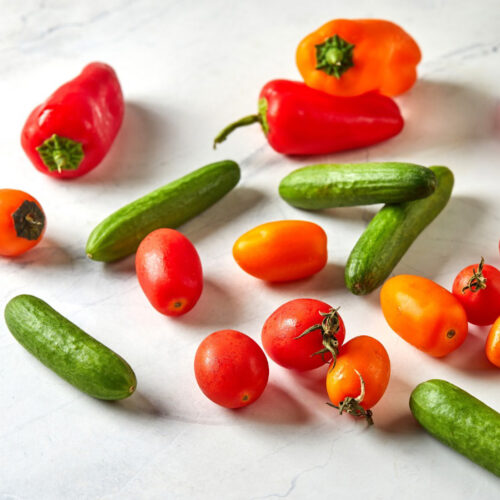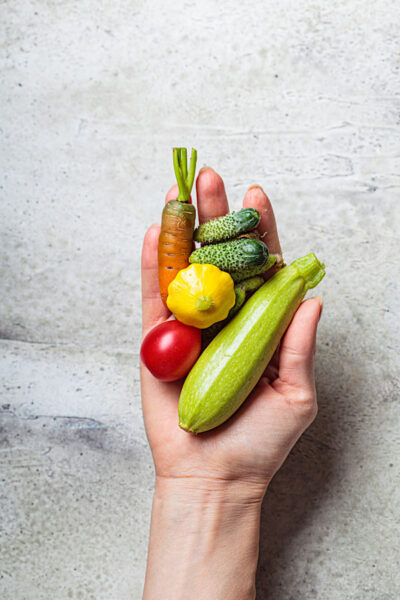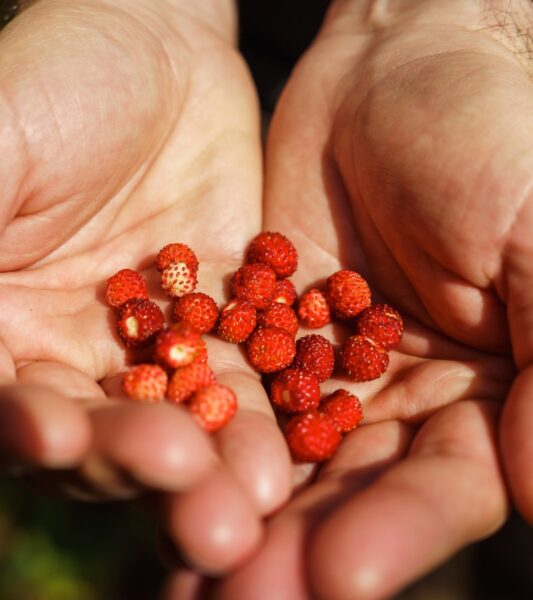Small space gardening often includes gardening on balconies. Balconies come in all sizes, but most are on the smaller side. If your balcony is quite small you may want to focus on growing mini-vegetables (aka baby vegetables). This guide will help you decide which mini vegetable varieties to choose and what size container they need to flourish.

Jump to: Best Mini Veggies for a Small Balcony Kitchen Garden | Recommended Container Sizes
This post may contain affiliate links. As an Amazon Associate, I also earn from qualifying purchases. You can read our disclosure information here–
Although I live on a farm with plenty of growing space, I am testing different types of kitchen garden arrangements so that I can share my growing experience with city or urban dwellers that have limited space.
These are the varieties I have chosen for my 2024 test balcony garden (check back later for some before and after photos):
Favorite Mini Vegetable Varieties for My Balcony Container Garden
- Peas: ‘Tom Thumb’ – 8 to 9″ tall, grown mainly as a shelling type, but the pods are also sweet & tender when harvested very young. Heirloom, frost tolerant and no staking!
- Tomatoes: I like ‘Tumbler’ for hanging baskets, ‘Gardeners Delight’ for a red heirloom cherry and ‘Sun Gold’ for a sweet orange cherry, and ‘Bush Beefsteak’ for a large slicer that can be grown in a pot as it is a determinate tomato variety.
- Eggplant: ‘Patio Baby’ – Ideal for containers; spineless variety provides with early yields of 2–3 inch long, egg-shaped fruit on plants no taller than 24 inches.
- Peppers: Most peppers grow well in pots. I like to include an early jalapeno and a sweet variety called ‘Pizza My Heart’.
- Carrots: ‘Bambino’ – petite and tender gourmet carrot thats grows perfectly in containers. Harvest at 4” and sow a few plantings throughout the season for an extended harvest.
- Radish: all radishes grow well in balcony gardens. I include a red round radish and a white daikon.
- Beans: Bush green beans do well in containers (try ‘Bush Blue Lake’ or ‘Contender’ for flavor); Pole beans can be grown on balcony garden but will need a larger container and a trellis system.
- Strawberries: ‘Alpine’ – perennial plants yield continuous harvests of tiny, 3/4 inch berries with an intensely concentrated flavor; no runners and great for hanging baskets.
- Cucumbers: ‘Early Fortune’ (2″ by 8″) and ‘Adam Gherkin’ (2-3″ long)
- Cauliflower: ‘Baby’ (mini cauliflower producing 3-4” baby-sized heads)
- Broccoli: ‘Aspabroc’ (gourmet quality baby broccoli or broccolini produces tender, delicious, elongated stems topped with small, domed, 2 ½ inch florets).
- Beet: ‘Babybeat’ round mini beet with the earliest harvest of all beet varieties.

More Balcony Garden Vegetable Options
If your balcony is on the larger side, you may be able to grow more varieties of vegetables, and perhaps even some larger vegetables that can grow up a trellised wall. If you want to explore more varieties, check out this chart of balcony vegetable varieties (includes tips on growing in containers).
Did you know that you can also grow root vegetables such as potatoes, turnips and parsnips? Just make sure that the pots used for your crops are at least 15 inches deep to give the vegetables enough room to grow.

What Size Pot to Use for Vegetables?
When choosing containers, check the labels or seed packets to see what the mature size of the plant will be. Pots that are too small will not allow enough room for the roots and will diminish the yield. Small pots also dry out quickly, so go as big as you can given your particular space.
Tip: The bigger the container, the lower-maintenance it will be, in particular when it comes to watering and feeding, which you won’t need to do as often.
The chart below relates to mini vegetables in particular, but the information is similar for regular size vegetables.
| Plant | Diameter | Number of Plants | Depth of Pot |
|---|---|---|---|
| Peas | vining plant; needs trellis | ||
| Determinate Tomato | 18-24″ non-vining; no support | 1 plant | (~12-14: deep pot) |
| Indeterminate Tomato | 21-24″ vining; needs support | 1 plant | (~12-14″ deep pot) |
| Baby Eggplant | 12″ | 1 plant | 10″ deep pot |
| Peppers | 12″ | 1 plant | minimum 8″ deep pot |
| Carrots | 12″ | 12-14 plants | needs thinning; 8″ deep pot |
| Radish | 12″ | 12 plants | can use shallow pot |
| Bush Beans | 12″ | 2 plants | 6″ deep pot |
| Alpine strawberries | 10″ | 3 plants | great in hanging basket |
| Cucumber (Gherkin) | 12″ | vining; needs trellis | |
| Broccolini | 12″ | 1 plant | 10″ deep pot |
| Baby beets | 6″ deep pot |
Leave a comment below with any questions, and stay tuned for the before and after shots!


Leave a comment